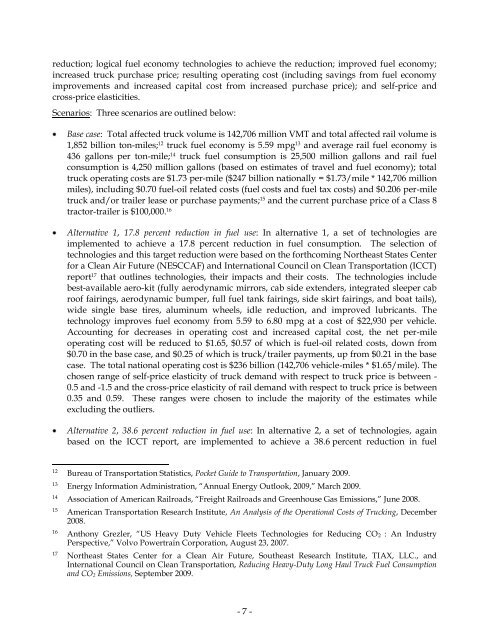Assessment of Fuel Economy Technologies for Medium and Heavy ...
Assessment of Fuel Economy Technologies for Medium and Heavy ...
Assessment of Fuel Economy Technologies for Medium and Heavy ...
Create successful ePaper yourself
Turn your PDF publications into a flip-book with our unique Google optimized e-Paper software.
eduction; logical fuel economy technologies to achieve the reduction; improved fuel economy;<br />
increased truck purchase price; resulting operating cost (including savings from fuel economy<br />
improvements <strong>and</strong> increased capital cost from increased purchase price); <strong>and</strong> self-price <strong>and</strong><br />
cross-price elasticities.<br />
Scenarios: Three scenarios are outlined below:<br />
Base case: Total affected truck volume is 142,706 million VMT <strong>and</strong> total affected rail volume is<br />
1,852 billion ton-miles; 12 truck fuel economy is 5.59 mpg 13 <strong>and</strong> average rail fuel economy is<br />
436 gallons per ton-mile; 14 truck fuel consumption is 25,500 million gallons <strong>and</strong> rail fuel<br />
consumption is 4,250 million gallons (based on estimates <strong>of</strong> travel <strong>and</strong> fuel economy); total<br />
truck operating costs are $1.73 per-mile ($247 billion nationally = $1.73/mile * 142,706 million<br />
miles), including $0.70 fuel-oil related costs (fuel costs <strong>and</strong> fuel tax costs) <strong>and</strong> $0.206 per-mile<br />
truck <strong>and</strong>/or trailer lease or purchase payments; 15 <strong>and</strong> the current purchase price <strong>of</strong> a Class 8<br />
tractor-trailer is $100,000. 16<br />
Alternative 1, 17.8 percent reduction in fuel use: In alternative 1, a set <strong>of</strong> technologies are<br />
implemented to achieve a 17.8 percent reduction in fuel consumption. The selection <strong>of</strong><br />
technologies <strong>and</strong> this target reduction were based on the <strong>for</strong>thcoming Northeast States Center<br />
<strong>for</strong> a Clean Air Future (NESCCAF) <strong>and</strong> International Council on Clean Transportation (ICCT)<br />
report 17 that outlines technologies, their impacts <strong>and</strong> their costs. The technologies include<br />
best-available aero-kit (fully aerodynamic mirrors, cab side extenders, integrated sleeper cab<br />
ro<strong>of</strong> fairings, aerodynamic bumper, full fuel tank fairings, side skirt fairings, <strong>and</strong> boat tails),<br />
wide single base tires, aluminum wheels, idle reduction, <strong>and</strong> improved lubricants. The<br />
technology improves fuel economy from 5.59 to 6.80 mpg at a cost <strong>of</strong> $22,930 per vehicle.<br />
Accounting <strong>for</strong> decreases in operating cost <strong>and</strong> increased capital cost, the net per-mile<br />
operating cost will be reduced to $1.65, $0.57 <strong>of</strong> which is fuel-oil related costs, down from<br />
$0.70 in the base case, <strong>and</strong> $0.25 <strong>of</strong> which is truck/trailer payments, up from $0.21 in the base<br />
case. The total national operating cost is $236 billion (142,706 vehicle-miles * $1.65/mile). The<br />
chosen range <strong>of</strong> self-price elasticity <strong>of</strong> truck dem<strong>and</strong> with respect to truck price is between -<br />
0.5 <strong>and</strong> -1.5 <strong>and</strong> the cross-price elasticity <strong>of</strong> rail dem<strong>and</strong> with respect to truck price is between<br />
0.35 <strong>and</strong> 0.59. These ranges were chosen to include the majority <strong>of</strong> the estimates while<br />
excluding the outliers.<br />
Alternative 2, 38.6 percent reduction in fuel use: In alternative 2, a set <strong>of</strong> technologies, again<br />
based on the ICCT report, are implemented to achieve a 38.6 percent reduction in fuel<br />
12<br />
Bureau <strong>of</strong> Transportation Statistics, Pocket Guide to Transportation, January 2009.<br />
13<br />
Energy In<strong>for</strong>mation Administration, ―Annual Energy Outlook, 2009,‖ March 2009.<br />
14<br />
Association <strong>of</strong> American Railroads, ―Freight Railroads <strong>and</strong> Greenhouse Gas Emissions,‖ June 2008.<br />
15<br />
American Transportation Research Institute, An Analysis <strong>of</strong> the Operational Costs <strong>of</strong> Trucking, December<br />
2008.<br />
16<br />
Anthony Grezler, ―US <strong>Heavy</strong> Duty Vehicle Fleets <strong>Technologies</strong> <strong>for</strong> Reducing CO 2 : An Industry<br />
Perspective,‖ Volvo Powertrain Corporation, August 23, 2007.<br />
17<br />
Northeast States Center <strong>for</strong> a Clean Air Future, Southeast Research Institute, TIAX, LLC., <strong>and</strong><br />
International Council on Clean Transportation, Reducing <strong>Heavy</strong>-Duty Long Haul Truck <strong>Fuel</strong> Consumption<br />
<strong>and</strong> CO 2 Emissions, September 2009.<br />
- 7 -
















